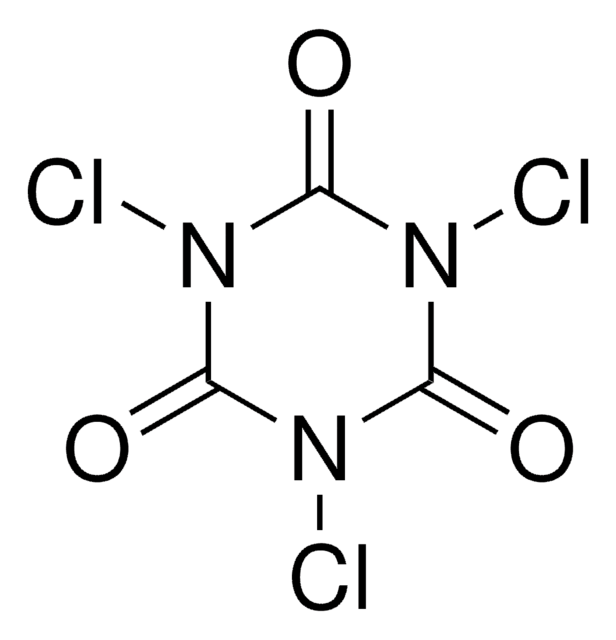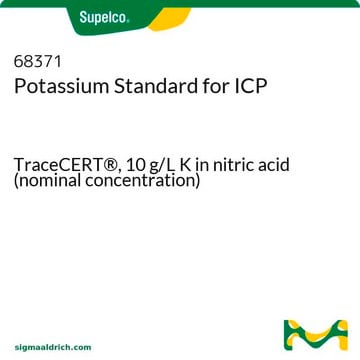218928
Sodium dichloroisocyanurate
96%
Synonim(y):
NaDCC, 3,5-Dichloro-2-hydroxy-4,6-s-triazinedione sodium salt, Dichloro-s-triazinetrione sodium salt
About This Item
Polecane produkty
Próba
96%
Postać
(Granules or Granular Powder)
przydatność reakcji
reagent type: oxidant
ciąg SMILES
[Na]N1C(=O)N(Cl)C(=O)N(Cl)C1=O
InChI
1S/C3HCl2N3O3.Na/c4-7-1(9)6-2(10)8(5)3(7)11;/h(H,6,9,10);/q;+1/p-1
Klucz InChI
MSFGZHUJTJBYFA-UHFFFAOYSA-M
Szukasz podobnych produktów? Odwiedź Przewodnik dotyczący porównywania produktów
Powiązane kategorie
Opis ogólny
Zastosowanie
- N-monochlorination and dehydrochlorination of amino esters
- Chlorination to detect ammonium via formation of colored zebra-bands in a deteting tube
- Synthesis of antimicrobial polyurethane additives to control biofilm
- Preparation of bromochloroisocyanurate for electrophilic cobromination of alkenes and bromination of arenes
- An oxidizing reagent for the preparation of tetrazene(N–N=N–N)-linked bi(1,2,4-triazole) from 4-amino-1,2,4-triazole by oxidizing N-NH2 functional group.
- A chlorinating agent for the N-monochlorination of α-amino esters and α-amino-β-diesters.
It can also be used to prepare NaDCC immobilized magnetic nano-Fe3O4 material, which is used as an excellent disinfectant as well as a wastewater treatment agent.
Oświadczenie o zrzeczeniu się odpowiedzialności
Hasło ostrzegawcze
Danger
Zwroty wskazujące rodzaj zagrożenia
Zwroty wskazujące środki ostrożności
Klasyfikacja zagrożeń
Acute Tox. 4 Oral - Aquatic Acute 1 - Aquatic Chronic 1 - Eye Dam. 1 - Ox. Sol. 2 - Skin Corr. 1A - STOT SE 3
Organy docelowe
Respiratory system
Zagrożenia dodatkowe
Kod klasy składowania
4.1A - Other explosive hazardous materials
Klasa zagrożenia wodnego (WGK)
WGK 2
Temperatura zapłonu (°F)
Not applicable
Temperatura zapłonu (°C)
Not applicable
Środki ochrony indywidualnej
Eyeshields, Gloves, type P3 (EN 143) respirator cartridges
Certyfikaty analizy (CoA)
Poszukaj Certyfikaty analizy (CoA), wpisując numer partii/serii produktów. Numery serii i partii można znaleźć na etykiecie produktu po słowach „seria” lub „partia”.
Masz już ten produkt?
Dokumenty związane z niedawno zakupionymi produktami zostały zamieszczone w Bibliotece dokumentów.
Klienci oglądali również te produkty
Nasz zespół naukowców ma doświadczenie we wszystkich obszarach badań, w tym w naukach przyrodniczych, materiałoznawstwie, syntezie chemicznej, chromatografii, analityce i wielu innych dziedzinach.
Skontaktuj się z zespołem ds. pomocy technicznej














